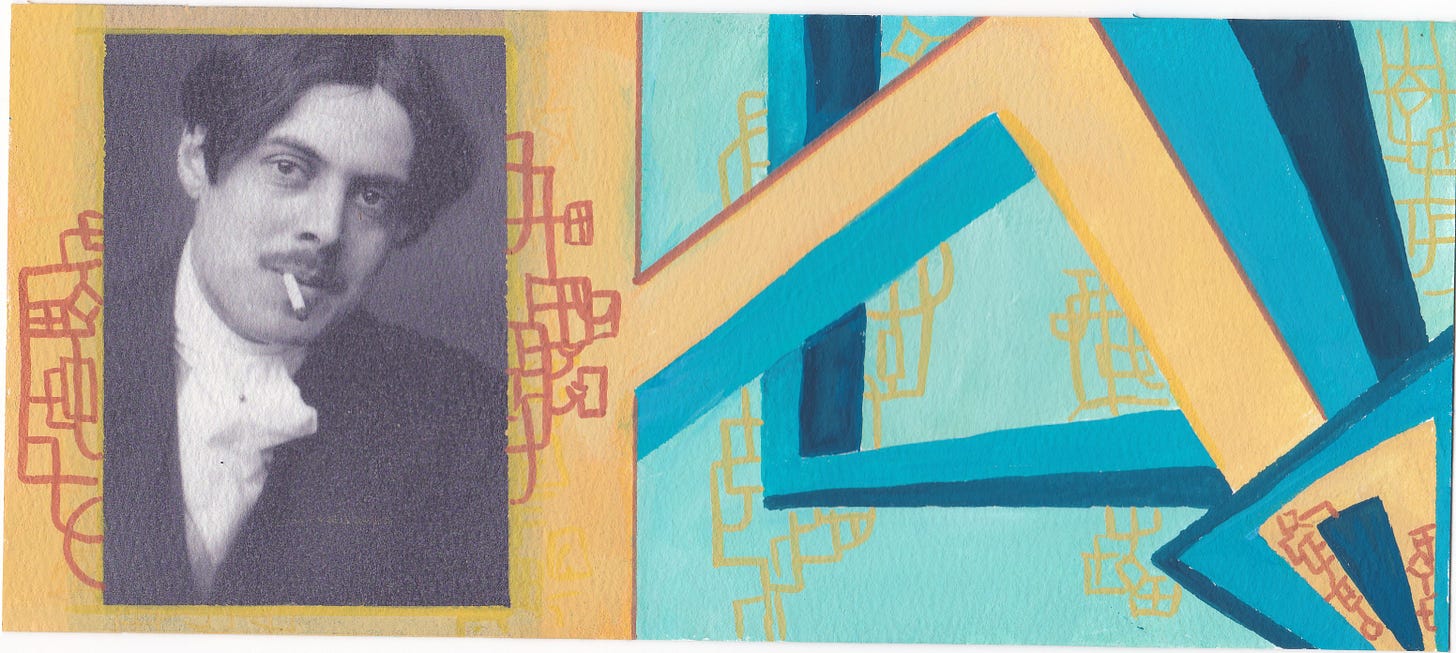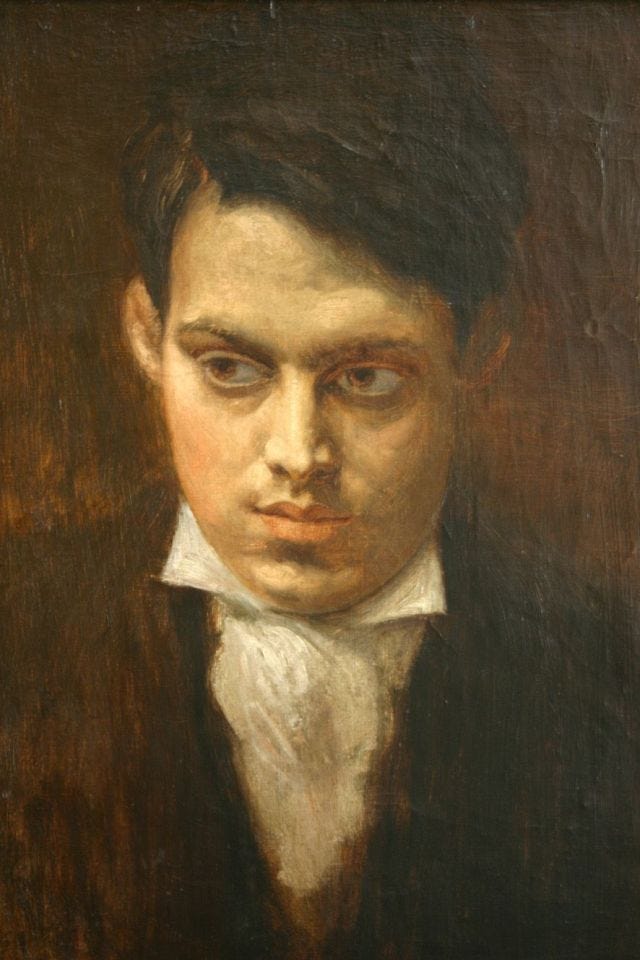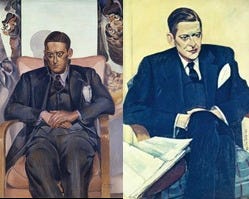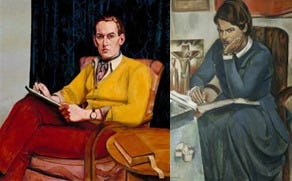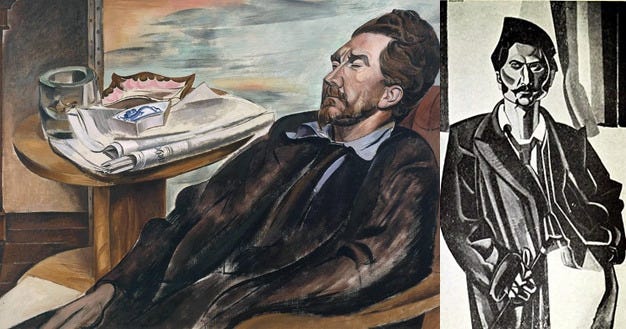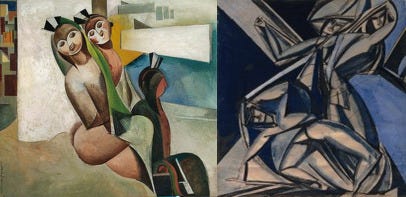POETS Day! Percy Wyndham Lewis
Percy Wyndham Lewis was friends with Eliot, Pound, and many renowned poets, all of whom I hope gave him hell for the “Hindu/two” rhyme.
I’ve been in Italy, so I missed a few POETS Day Fridays, or “Fridays” as the Italians call them, but with an accent (everybody over there except one Salerno cab driver speaks English, and I have my suspicions about him.)
Anyway, Piss Off Early, Tomorrow’s Saturday. Cut out of work while the sun’s still out and enjoy a heat-staving scoop or two of gelato at any one of whatever block’s you happen to be on many gelaterias. Gather a few friends and put your heads together to figure out why you’re encouraged to touch this Coliseum wall but get snipped at by security if you touch that identical one. Hold up a lemon bigger than your head. Swim in ridiculously blue seas while staying determinedly out of any body called a canal. Very refreshing.
First, a little verse.
***
Augustus John’s portraits tell stories. Frightful stories on occasion. I read somewhere some time ago, so forgive the lack of attribution, that he could be so insightful – and equally capable of conveying his insights – as to be “cruel.” His Roy Campbell adorns the cover of Peter Alexander’s biography of the poet. Campbell, pre-paunch and balding, looks impressionable in his Spanish countryman get-up. John’s painting sets the stage for Alexander’s telling of a man of immense talents swayed by passions he mostly grasped. It’s a great book, but I judge the cover better.
John casts Percy Wyndham Lewis as a mischievous schoolboy; an imp bored between capers. I’m used to Lewis presented visually as a Lothario. Goth vampires weren’t in vogue in the first half of the twentieth century, but he did the legwork, laying down a template for them to follow when the damned craze hit. Snidely Whiplash comes to mind. He’s courting an impression that says, “I’m the one your mom warned you about.” There’s some stock bad boy in the look he cultivated. John’s rendering shows us actual deviousness.
The mustaches are gone. He’s still dressed in dark colors, but the brown suit over white makes me think of pilgrims or belonging to a row of framed scholars foreshortening a dreary annex hall. Starched collar points and a puffy bit of what probably doesn’t qualify as an ascot complete the C of E drag. John didn’t seat him in a pew – that would have been too much – but the whole suggests that wherever Lewis sits, it’s somewhere that requires him to behave. He’s overfed, clean shaven, slightly smirking, and not making eye contact; a prospering cherub who picked up a bit of discarded apple.
Lewis wrote poetry but was best known for his paintings and novels. Of his thirty-plus books, only one was a collection of verse. I suppose he could have fancied himself a poet at heart. All the abstractions and character arcs may have been what he did to satisfy his landlord, go out drinking and bunny hopping, and buy busily cuffed shirts. He was a poet and all the rest was a concession to financial realities. I doubt it. Unlike his novels (I’m told) and his painting, his poetry isn’t very good. He tries to be clever, but gets hampered because he’s actually clever and gums it all up in intention.
His portraits, the ones he painted, could be wonderful. He made at least two of T.S. Eliot whose work first appeared in England in Blast, a magazine co-founded by Lewis and Ezra Pound. The first shows an unassuming man practically hiding in a respectable but ill-fitting suit. The second, a later work, has Eliot at ease. This time the suit is bright and eye-catching with a large handkerchief as plumage in the breast pocket. The poet-playwright transformed the drab banker. It’s good stuff.
He did what I’d call semi-realistic portraits and someone with an art background would call something completely different, best described by me as paintings that strive to accurately reproduce an image without attempting realism. It’s not impressionistic but it’s not precise. They’re a convention by which the artist says this isn’t what this person looks like so much as what this person looks like when painted in oil. That’s the sense I get looking at his portraits of Nigel Tangye and Naomi Mitchison. The artist’s intent is realized without the precision expected in a Caravaggio, for instance.
He painted Ezra Pound several times, but two stand out. The first is, in the Tangye/Mitchison style, Pound in repose. He’s an older and accomplished man relaxing while hopefully not pondering treason. The other is highly stylized and energetic. It’s the public Pound, the image cultivated by green velvet suits with blue buttons and imperious declarations of “Make it new!”
Lewis was exuberantly abstract when he wanted to be. Pound called Lewis’s jazzed up Cubism offshoot Vorticism. It made a splash and had imitators and doubtless has descendants someone better versed in art than I can tell you about. To me it’s love it or leave it. I’m awed by Beach Babies and Les danseurs. I like his work with figures in action. Some of the purer abstractions that look like cityscapes or energy drink labels leave me scratching my head. Some are okay.
I think of Lewis when I think about popular painting’s shift towards and acceptance of hard abstraction. That’s a fan’s association and certainly lacking. Impressionism had been around for a long time and rustic work came before everything else. I think of Lewis’s time and career because he painted as photography relieved painters of their documentary responsibilities. I’m sure some painters felt threatened by the new technology, but others, consciously or not, turned their talent towards expressing what photography could not.
AI can write an 80,000 word novel in seconds. Give it few prompts and hit enter. I say it can’t be as good as people writing. All AI can do is farm what others have written and collate. But I’m terrified that I might read an AI novel blind and not know the difference.
Reading about AI writing made me think of Lewis and his cohort. The parallel isn’t perfect because AI is set to ape all the ape-able stuff, but photographs do a better job capturing an image dutifully than paintings so artists, consciously or not, focused on aspects beyond a camera’s reach. Writing is threatened completely. It’s not just aspects.
I’m torn between thinking we’ll hold out in redoubts inaccessible to AI like the painters did when photography threatened or that we’ll cede an art to AI like the painters did when photography threatened. They aren’t happy thoughts, but they brought me to Lewis again.
You can see him tripping over an attempt at conversational verse here. In addition to Eliot and Pound, he was friends with a great many renowned poets, all of whom I hope gave him hell for the “Hindu/two” rhyme.
A Portentous start — to take a snapshot aim
Percy Wyndham Lewis (1882-1957)A portentous start — to take a snapshot aim
At Backs in the abstract — but you see my game —
To shoot off all the epaulettes and bustles,
To flatten out the controversial muscles
Which hint at four-armed fool-gods of the Hindu,
Furnished with dorsal duplicates for the two
Front-handed members, a peg-top of a person.
So kindly overlook my rude aspersion —
No by-your-leave as an ” Eyes-front” contraption
To salute your honour — ” One-Way” is my caption,
For better or for worse. I am the song bird
Of the dogmatic one-way Front-Man. I exert
Each day a ton of energy on this,
Just this — to bolster up all onewayness.
Ah, once you’ve said progress ! — in that little matter
I confess to being as mad as a March Hatter!
[This entry is cross posted at ordinary-times.com]


